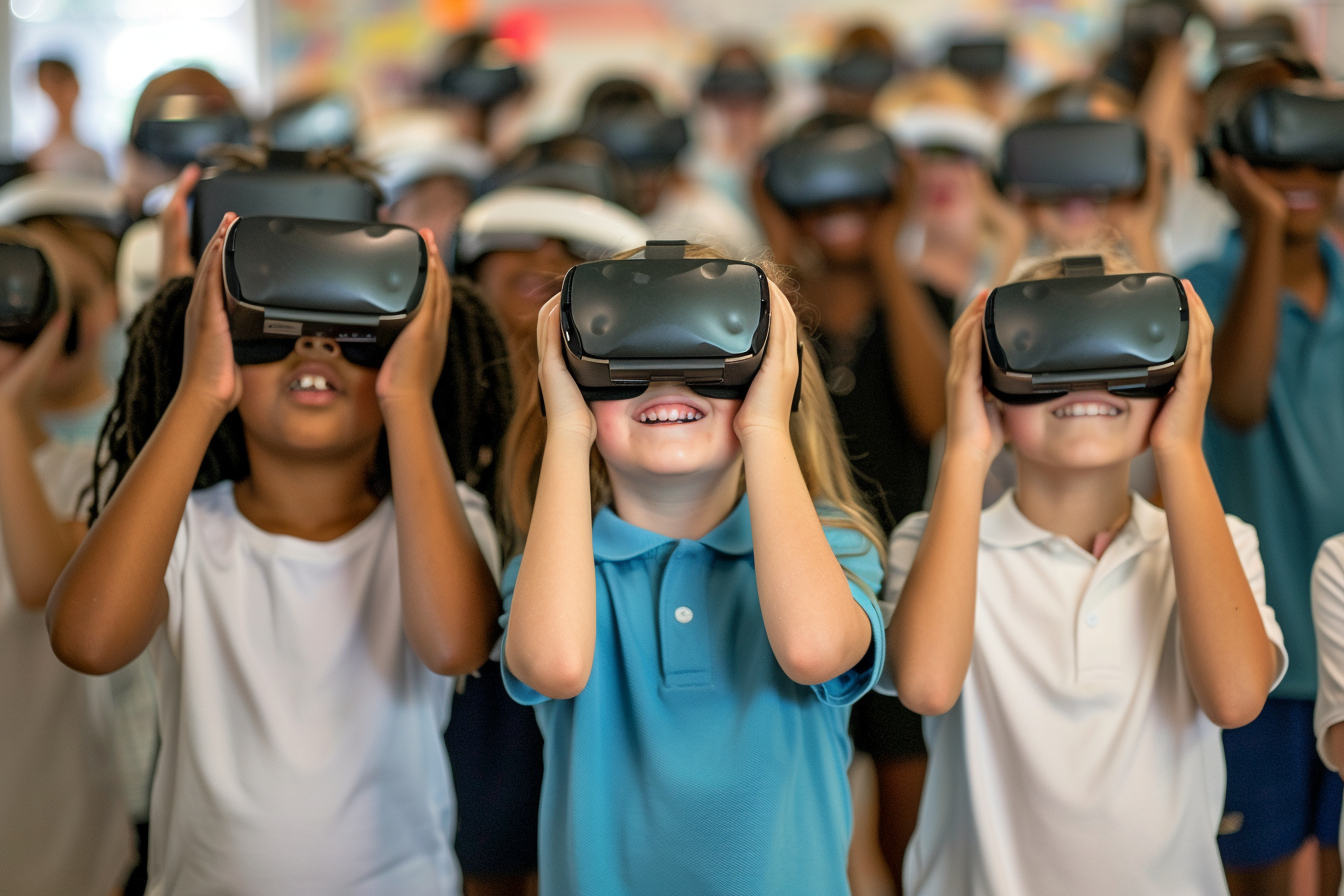Virtual Reality Field Trips: Bringing the World to Your Classroom
Virtual reality field trips engage students with immersive, cost-effective journeys that bring history, science, and culture alive in your classroom.

Imagine a classroom where students can explore ancient civilizations, dive into the depths of the ocean, or journey through space without ever leaving their desks. Virtual reality (VR) is making this possible, transforming traditional field trips into immersive, flipped experiences that captivate students and enhance learning. Flipped field trips using VR technology are revolutionizing education by bringing the world directly into the classroom.
In today's digital age, access to high-quality educational experiences is more important than ever. Traditional field trips, while valuable, often come with logistical challenges and limitations. VR offers a solution by providing safe, cost-effective, and highly engaging alternatives that can be tailored to the curriculum. These virtual excursions enable students to experience places and events that might otherwise be inaccessible due to distance, cost, or time constraints.
We explore the principles, benefits, and practical applications of VR field trips, showcasing how they can enrich education and provide students with unforgettable learning experiences. Join us as we delve into the exciting world of flipped field trips and discover their potential to transform classroom learning. From historical tours to science expeditions, the possibilities are endless, and the impact on students' engagement and understanding can be profound.
Understanding Flipped Field Trips
Flipped field trips leverage virtual reality (VR) technology to create immersive educational experiences that can be accessed from the classroom. Unlike traditional field trips, where students travel to various locations, flipped field trips bring these locations to the students through VR. This approach allows for more flexible and frequent explorations of places that might otherwise be inaccessible due to distance, cost, or logistical constraints.
The concept of flipped field trips has evolved with advancements in VR technology, making it possible to recreate historical sites, scientific environments, cultural settings, and more. These virtual experiences are designed to be interactive, providing students with a deeper understanding of the subject matter. Core principles of flipped field trips include immersion, interactivity, and accessibility, ensuring that all students can benefit from these rich educational experiences.
Enjoy science fiction? Check out my space books HERE on Amazon!
By integrating VR into the curriculum, flipped field trips offer a unique way to enhance traditional learning methods, providing students with engaging and memorable educational opportunities.
Types of Virtual Reality Field Trips
Virtual reality field trips can take various forms, each offering unique learning experiences. Here are some common types:
- Historical Tours: Students can virtually visit historical sites and events, such as ancient Rome, the Great Wall of China, or the signing of the Declaration of Independence. These tours provide a vivid and immersive way to learn about history.
- Science Expeditions: VR can transport students to scientific phenomena and natural wonders, like exploring the depths of the ocean, walking through a rainforest, or witnessing volcanic eruptions. These expeditions bring science to life in a way that textbooks cannot.
- Cultural Immersions: Students can experience different cultures and global perspectives by virtually visiting countries, participating in cultural festivals, and interacting with diverse communities. This helps foster global awareness and empathy.
- Career Exploration: Virtual job shadowing allows students to explore various professions, from medicine to engineering, by experiencing a day in the life of professionals in these fields. This can help guide their future career choices.
- Space Adventures: VR can take students on journeys through the universe, exploring planets, stars, and galaxies, and learning about space science. These adventures ignite curiosity and interest in astronomy and space exploration.
By exploring these types of VR field trips, educators can provide students with diverse and enriching learning experiences.
Benefits of Virtual Reality Field Trips
Virtual reality field trips offer numerous advantages, making them a valuable addition to educational practices. Here are some key benefits:
- Enhanced Engagement: VR captures students' attention and interest, making learning more captivating and enjoyable. The immersive nature of VR helps students retain information better than traditional methods.
- Accessibility: VR field trips provide opportunities for all students to explore places and experiences that might be inaccessible due to geographical or financial constraints. This ensures equal learning opportunities for everyone.
- Safety and Convenience: Traditional field trips involve logistical challenges and potential risks. VR field trips eliminate these issues, allowing students to explore safely from their classroom.
- Cost-Effective: Virtual trips reduce the costs associated with transportation, admission fees, and other expenses. Schools can save money while still providing valuable educational experiences.
- Supplementary Learning: VR experiences complement classroom instruction by providing context and depth to the subject matter. They can be used to reinforce lessons and provide practical applications of theoretical concepts.
These benefits highlight the potential of VR to transform field trips into more effective and inclusive educational experiences. By understanding these advantages, educators and administrators can better appreciate the value of integrating VR field trips into their teaching strategies.
Implementing VR Field Trips in the Classroom
Implementing VR field trips in the classroom requires careful planning and preparation. The first step is selecting appropriate VR content that aligns with the curriculum. Teachers should choose experiences that enhance and complement their lesson plans, ensuring that the VR trips are educational and relevant.
Technology requirements are a key consideration. Schools need to ensure they have access to VR headsets and compatible devices. Investing in quality equipment and maintaining it properly is essential for a smooth experience.
Teacher training is crucial for the successful integration of VR. Educators need professional development to understand how to use VR technology effectively and how to incorporate it into their teaching. This training should cover both technical skills and pedagogical strategies.
Student orientation is also important. Preparing students for the VR experience and setting clear expectations helps them engage fully with the content. Explaining how the technology works and what they will experience can enhance their learning.
Integration with lessons is vital. VR field trips should be seamlessly incorporated into the curriculum, with follow-up activities that reinforce and expand on the VR experience. This can include discussions, projects, and assessments that tie the virtual trip back to the learning objectives.
Overcoming Challenges in VR Field Trips
Implementing VR field trips comes with its own set of challenges, but these can be effectively managed with strategic planning and collaboration. One major challenge is technical issues. Addressing potential technical difficulties requires proper maintenance of equipment and having a technical support plan in place.
Ensuring student accessibility is another challenge. Providing VR technology to all students, regardless of their socioeconomic status, requires schools to seek funding opportunities and partnerships. Equitable access ensures that no student is left out.
Teacher preparedness is crucial. Providing adequate training and ongoing support helps teachers feel confident and capable of integrating VR into their lessons. This includes both technical training and pedagogical strategies.
Budget constraints can be a barrier. Finding cost-effective solutions, such as grants and community partnerships, can help schools acquire the necessary resources. Prioritizing investments in VR technology can also make a significant difference.
Managing screen time is important. Balancing VR use with other instructional methods ensures that students benefit from a well-rounded educational experience without excessive screen exposure.
By addressing these challenges, schools can create a supportive and effective environment for implementing VR field trips.
Case Studies
Implementing VR field trips has led to notable successes in various educational settings across the country. Here are three case studies highlighting the impact of these methods:
Case Study 1: Historical VR Tours in a Virginia Middle School
A middle school in Virginia incorporated historical VR tours into their history curriculum. Students virtually visited ancient civilizations and key historical events. Teachers reported increased student engagement and a deeper understanding of historical contexts. Students found the experiences immersive and memorable, which enhanced their retention of historical facts.
Case Study 2: Science Expeditions in a California High School
A high school in California used VR to take students on science expeditions. Students explored ecosystems, witnessed geological formations, and observed astronomical phenomena. The program led to higher student interest in science subjects and improved performance in science classes. Teachers noted that the hands-on experiences helped clarify complex scientific concepts.
Case Study 3: Cultural Immersions in a New Mexico Elementary School
An elementary school in New Mexico introduced VR cultural immersions to teach students about different cultures around the world. Students virtually attended cultural festivals, explored landmarks, and interacted with communities. The initiative fostered empathy and global awareness among students, helping them appreciate cultural diversity and understand global perspectives.
Practical Tips for Educators and Administrators
Implementing VR field trips can be straightforward with the right approach. Here are some practical tips for educators and administrators to consider:
- Start with Pilot Programs: Test VR field trips with small groups before scaling up. This allows for adjustments based on initial feedback and results.
- Choose Quality Content: Select high-quality VR experiences that align with learning objectives. Ensuring that the content is educational and engaging is key to a successful VR trip.
- Integrate with Curriculum: Ensure VR field trips are connected to the curriculum and enhance learning outcomes. Incorporate follow-up activities to reinforce the virtual experiences.
- Seek Student Feedback: Gather input from students to improve future VR experiences. Understanding their perspectives can help tailor the program to better meet their needs.
- Leverage Community Resources: Partner with local organizations and experts for support and resources. Community involvement can enhance the educational value of VR field trips.
These tips can help educators and administrators create a successful and sustainable VR field trip program.
Future Trends in Virtual Reality Field Trips
The future of virtual reality field trips is evolving, with new trends enhancing their effectiveness and reach. Advancements in VR technology promise more immersive and interactive experiences. Innovations such as haptic feedback, enhanced graphics, and real-time interactions can make virtual field trips even more engaging.
Increased collaboration is another trend. Sharing VR content and experiences across schools and districts can provide a broader range of learning opportunities. Collaborative efforts can also lead to the development of richer and more diverse VR experiences.
Check out our engaging printable posters. CLICK HERE to explore!
Global learning opportunities are expanding. Virtual field trips can connect students to international experiences, fostering global awareness and understanding. Access to global perspectives enriches students’ educational experiences.
Personalized learning is gaining traction. Using data and analytics to tailor VR experiences to individual student needs and interests ensures that each student benefits from the program.
Sustainability and eco-friendly practices are becoming more important. Reducing the environmental impact of traditional field trips aligns with broader educational goals of promoting sustainability.
By staying updated with these trends, schools can continue to innovate and provide high-quality VR field trips for students.
Conclusion
Flipped field trips using virtual reality offer a revolutionary approach to enhancing classroom learning. By providing immersive, accessible, and engaging educational experiences, VR field trips can captivate students' interest and deepen their understanding of complex subjects. The success stories from Virginia, California, and New Mexico demonstrate the significant impact of VR on student engagement, comprehension, and empathy.
As educational technology continues to advance, integrating VR into the curriculum presents an exciting opportunity for schools. Overcoming challenges such as technical issues, accessibility, and budget constraints requires strategic planning and collaboration. By embracing future trends and leveraging innovative solutions, educators can ensure that VR field trips become a valuable and sustainable component of modern education, enriching the learning experiences of students across diverse educational settings.
Check out some of my latest science fiction books HERE on Amazon!
Transform your classroom into an inspiring and vibrant learning space with our beautifully designed printable posters! Perfect for engaging your students and enhancing your teaching environment, our poster bundles cover everything from historical philosophers to animals. CLICK HERE to explore our exclusive collections on Teachers Pay Teachers and give your students the motivational boost they need!
